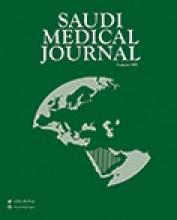Abstract
OBJECTIVE: To describe systemic lupus erythematosus (SLE) features among Arab children, and compare with cohorts from different ethnicities.
METHODS: This retrospective analysis of all published English literature on SLE in Arab children was conducted in March 2013. The percentage and frequencies of the clinical and laboratory features were collected, and compared between different Arab countries as well as Caucasian and South East Asian cohorts.
RESULTS: A total of 560 children from 5 Arab cohorts with an average age at diagnosis of 10 years; 7.7% of patients were diagnosed before the age of 5 years. Familial SLE was frequent. Most patients had major organ involvement. Renal involvement was diagnosed in 80%, while neuropsychiatric manifestations were seen in 30%. Immunosuppressive agents were commonly used. Beta cell depletion was recently introduced for refractory cases. The outcome of the disease could not be determined from the available data. However, 145 out of 300 patients had disease damage (52.6% Saudi and 43.9% Egyptian) with mean of 1.3 for Saudi and 0.93 for Egyptian. Forty patients died during the disease course due to infections and severe organ disease.
CONCLUSION: Systemic lupus erythematosus is common in Arab children, particularly familial SLE. The manifestations observed in Arabs are comparable with previous reports. However, there is a noticeable difference in the damage accrual and mortality rate between Arab and Canadian studies, which might reflect the disease severity.
- Copyright: © Saudi Medical Journal
This is an open-access article distributed under the terms of the Creative Commons Attribution-Noncommercial-Share Alike 3.0 Unported, which permits unrestricted use, distribution, and reproduction in any medium, provided the original work is properly cited.






